Phương pháp giáo dục phản biện cho lớp học tiếng Anh ở các trường đại học Việt Nam
Với mục đích phát triển tư duy phản biện cho người học, gần đây phương pháp giáo dục phản biện đã phát triển mạnh trong lĩnh vực giáo dục ngoại ngữ toàn cầu. Tuy nhiên, ở Việt Nam, phương pháp này vẫn còn chưa được nhiều người biết đến và vẫn còn rất nhiều hoài nghi xung quanh tính khả thi của phương pháp này. Bài báo này sẽ tập trung khái quát những khái niệm và mục tiêu chủ yếu của phương pháp giáo dục phản biện, từ đó đưa ra lí do cho việc áp dụng tư duy phản biện vào việc dạy và học tiếng Anh ở các trường đại học Việt Nam
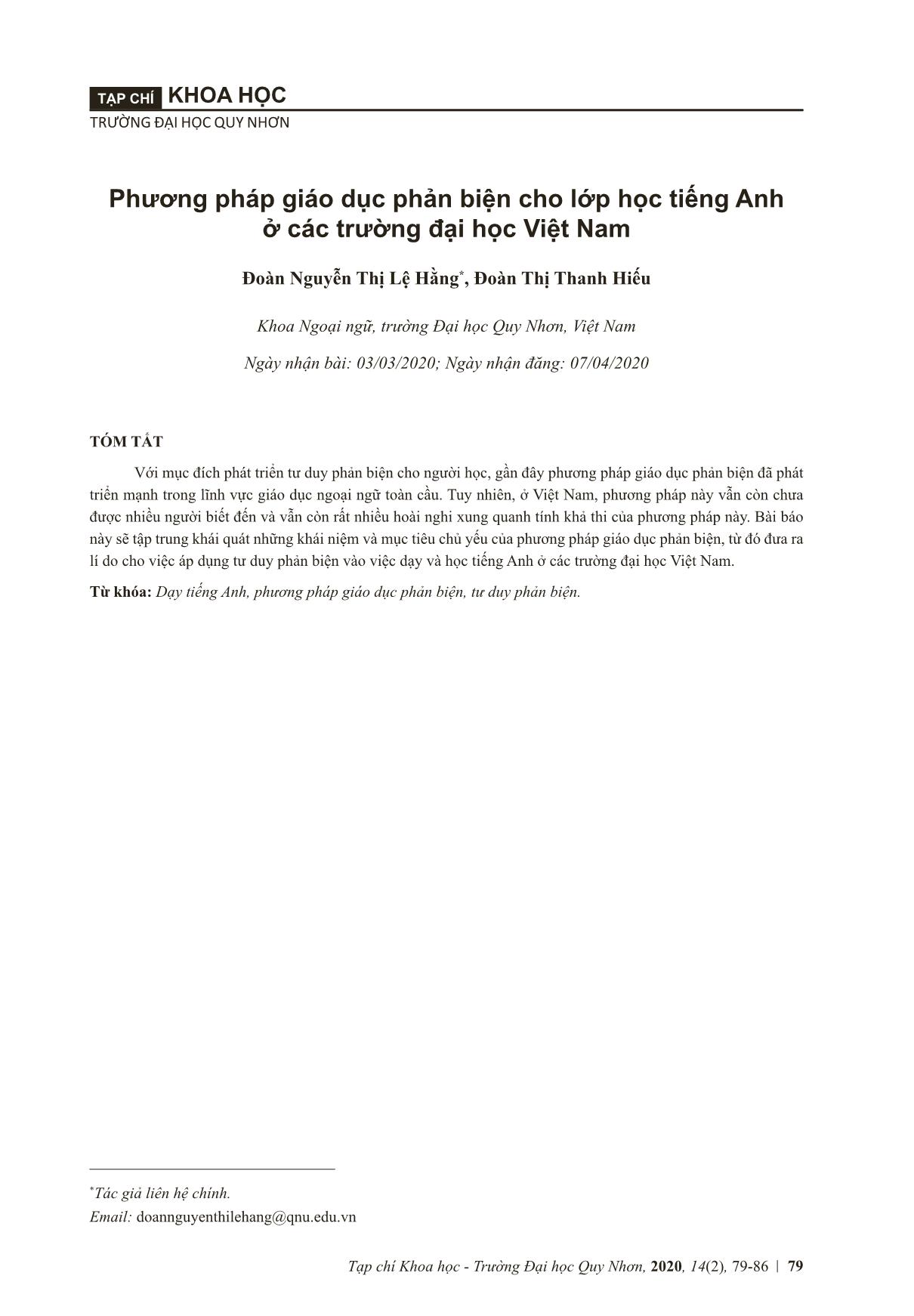
Trang 1
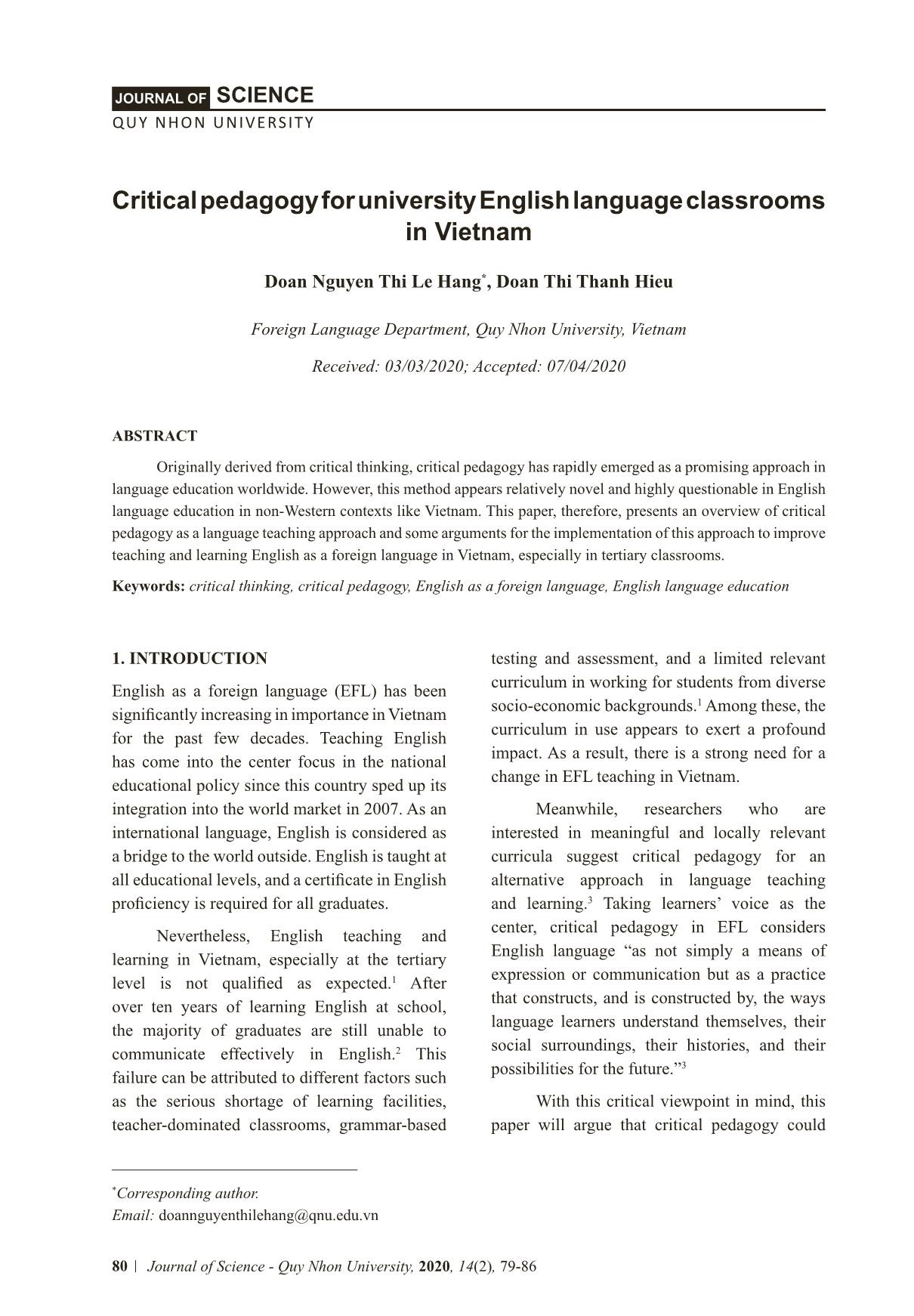
Trang 2
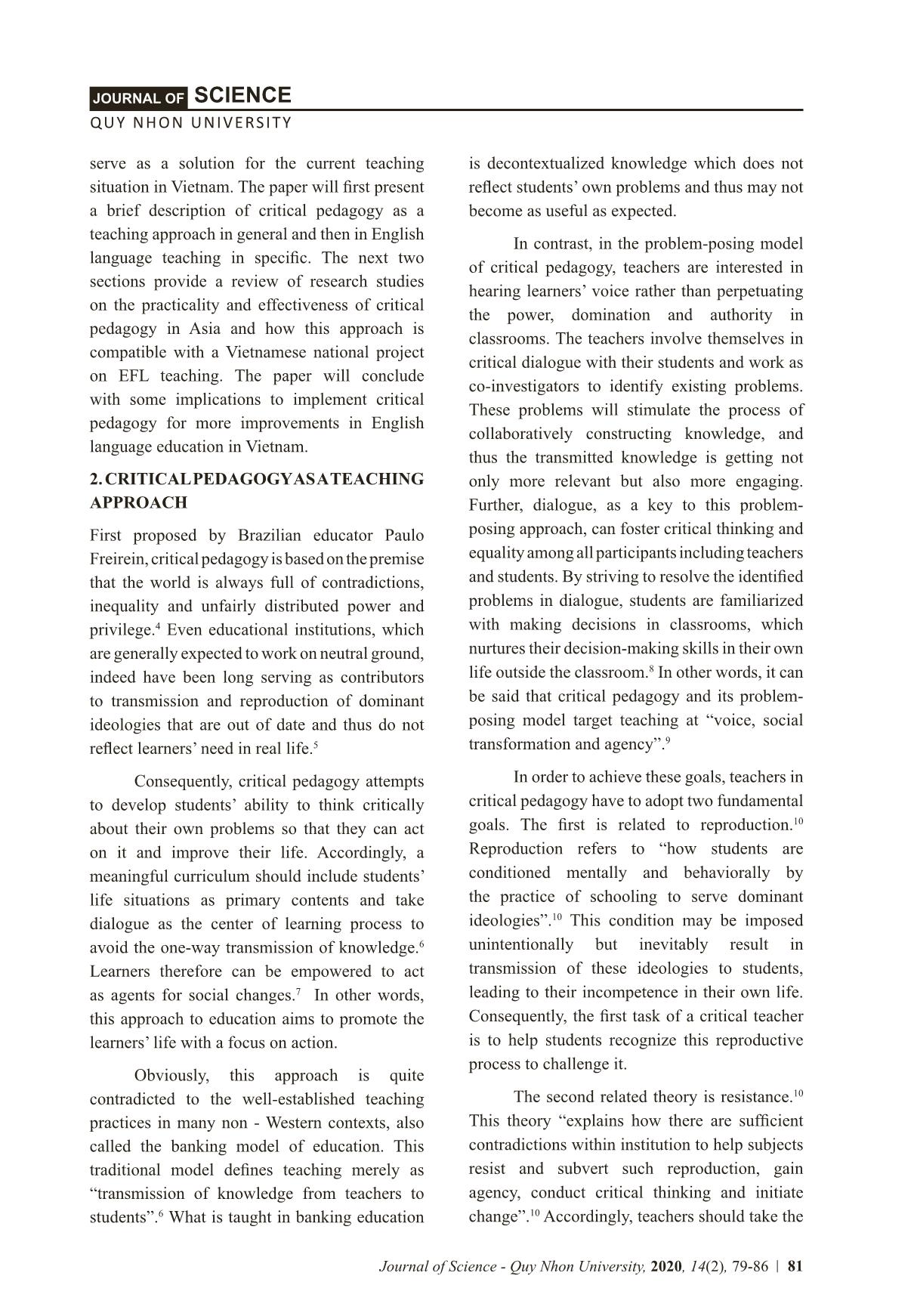
Trang 3
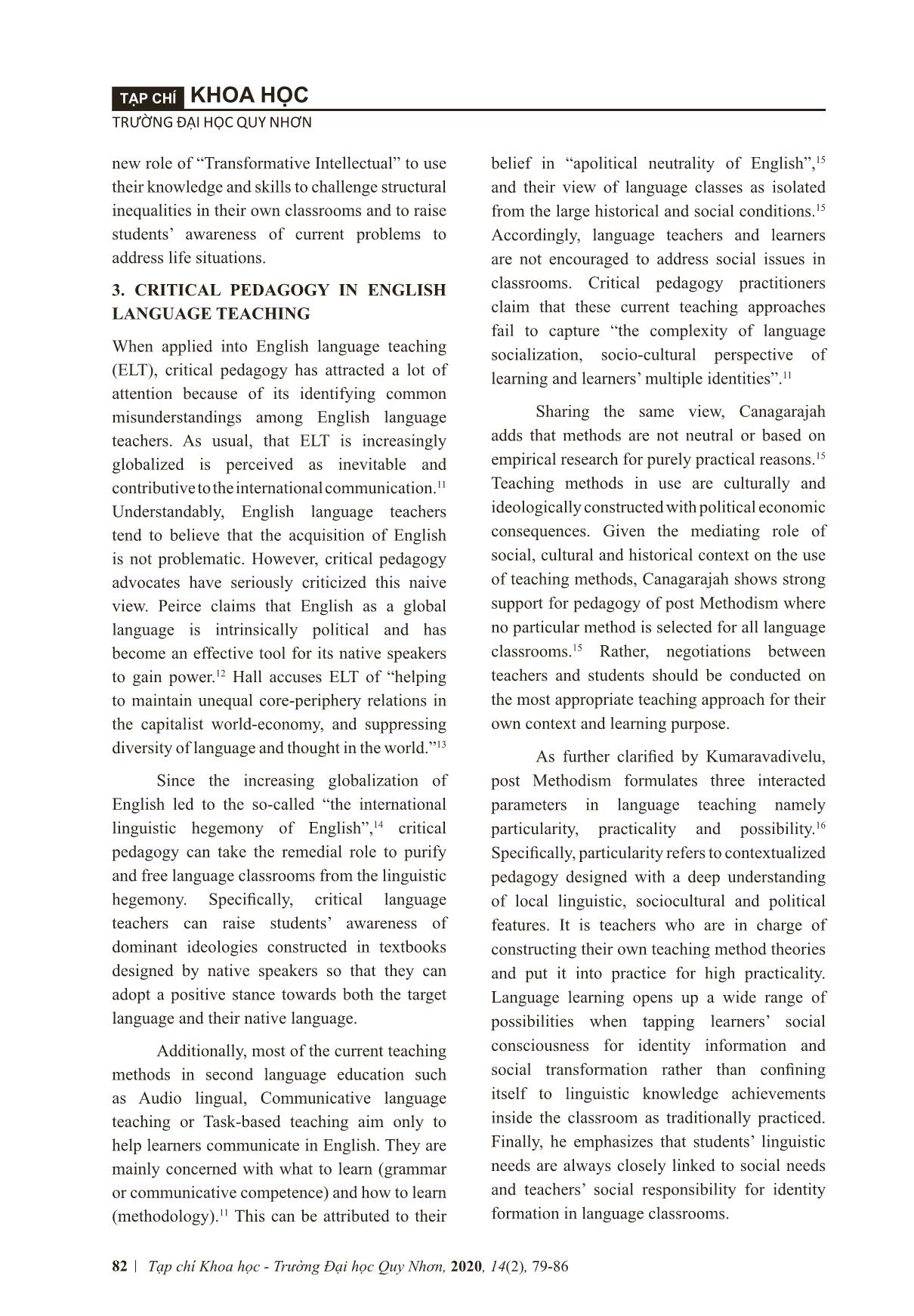
Trang 4
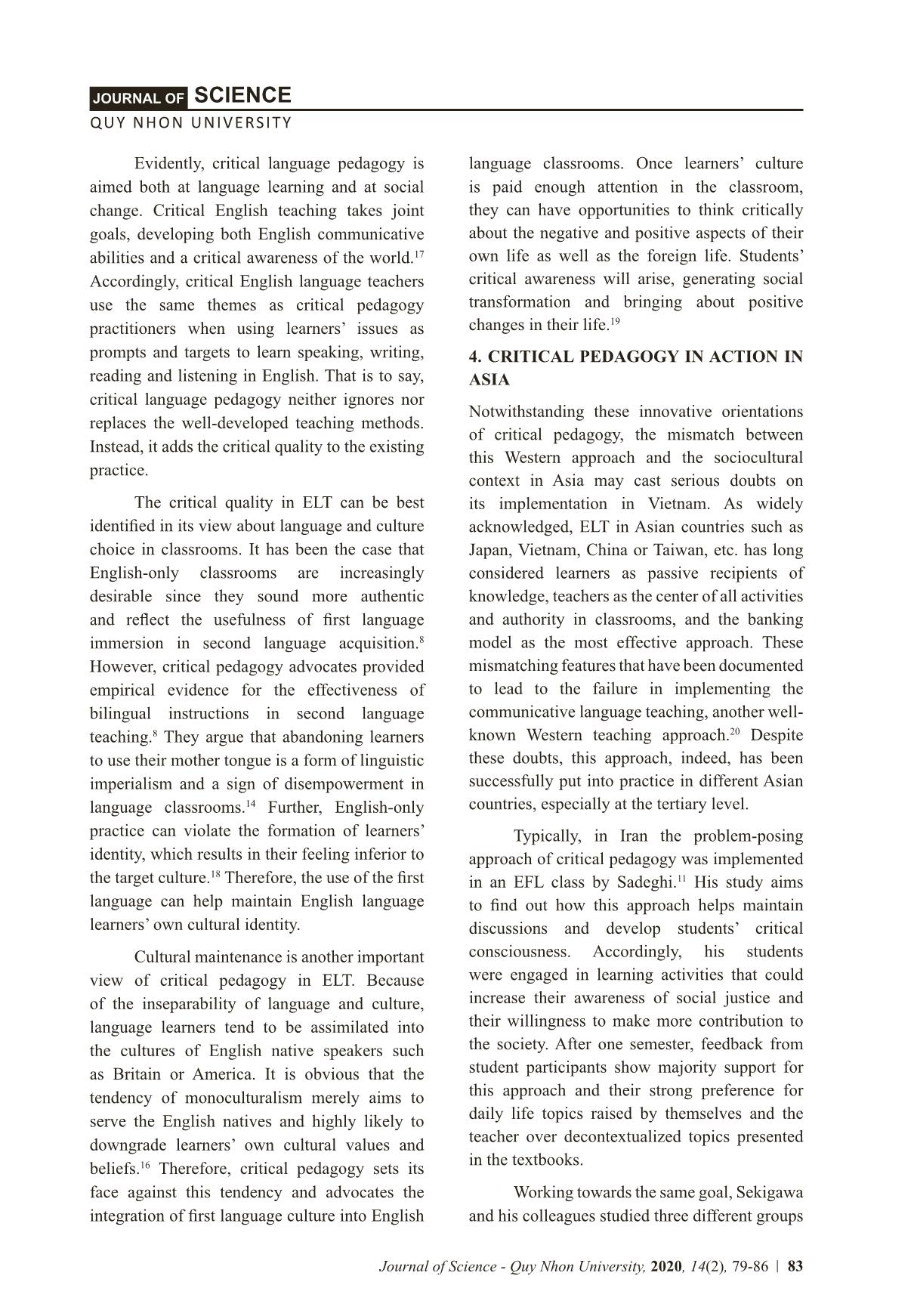
Trang 5
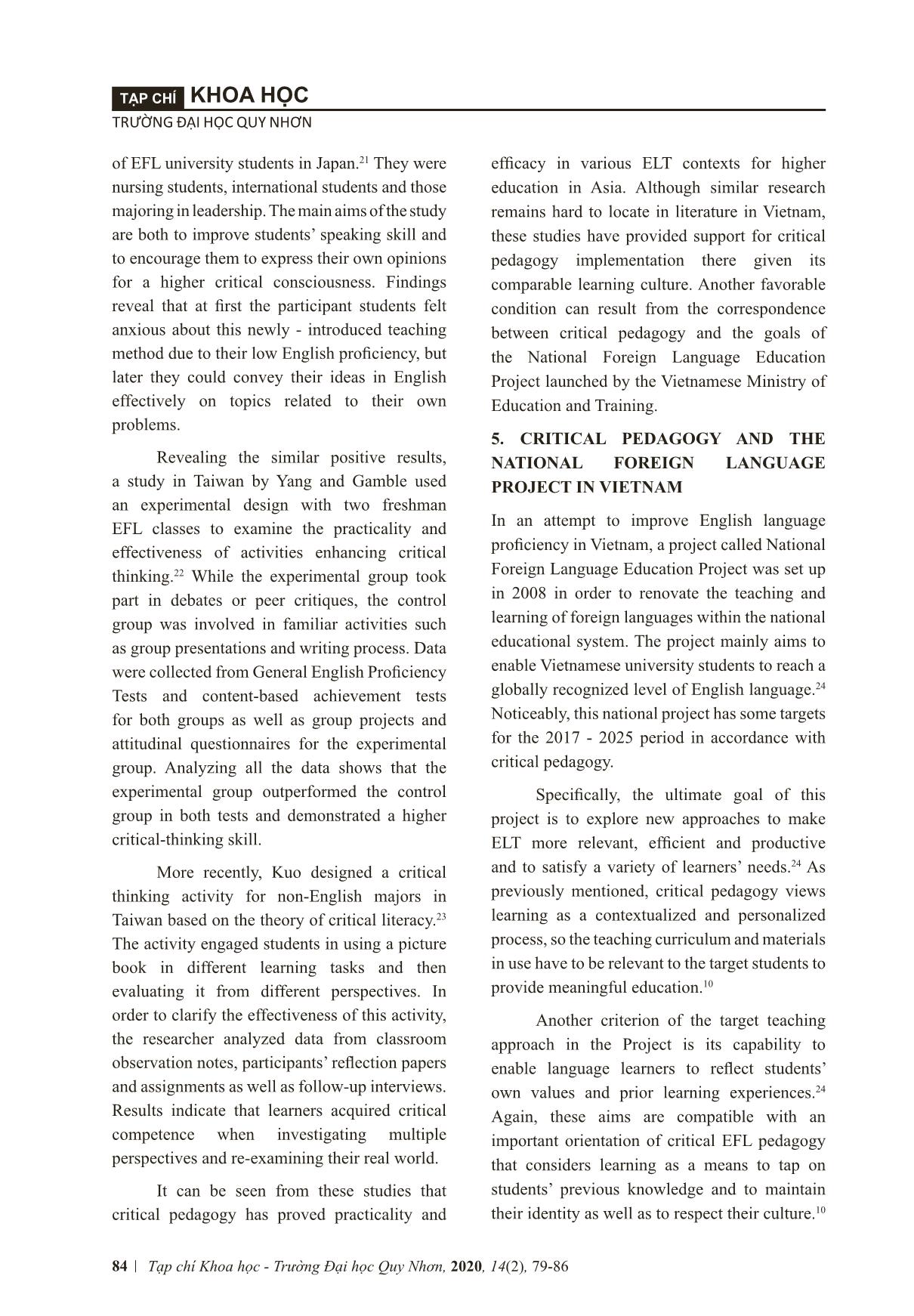
Trang 6
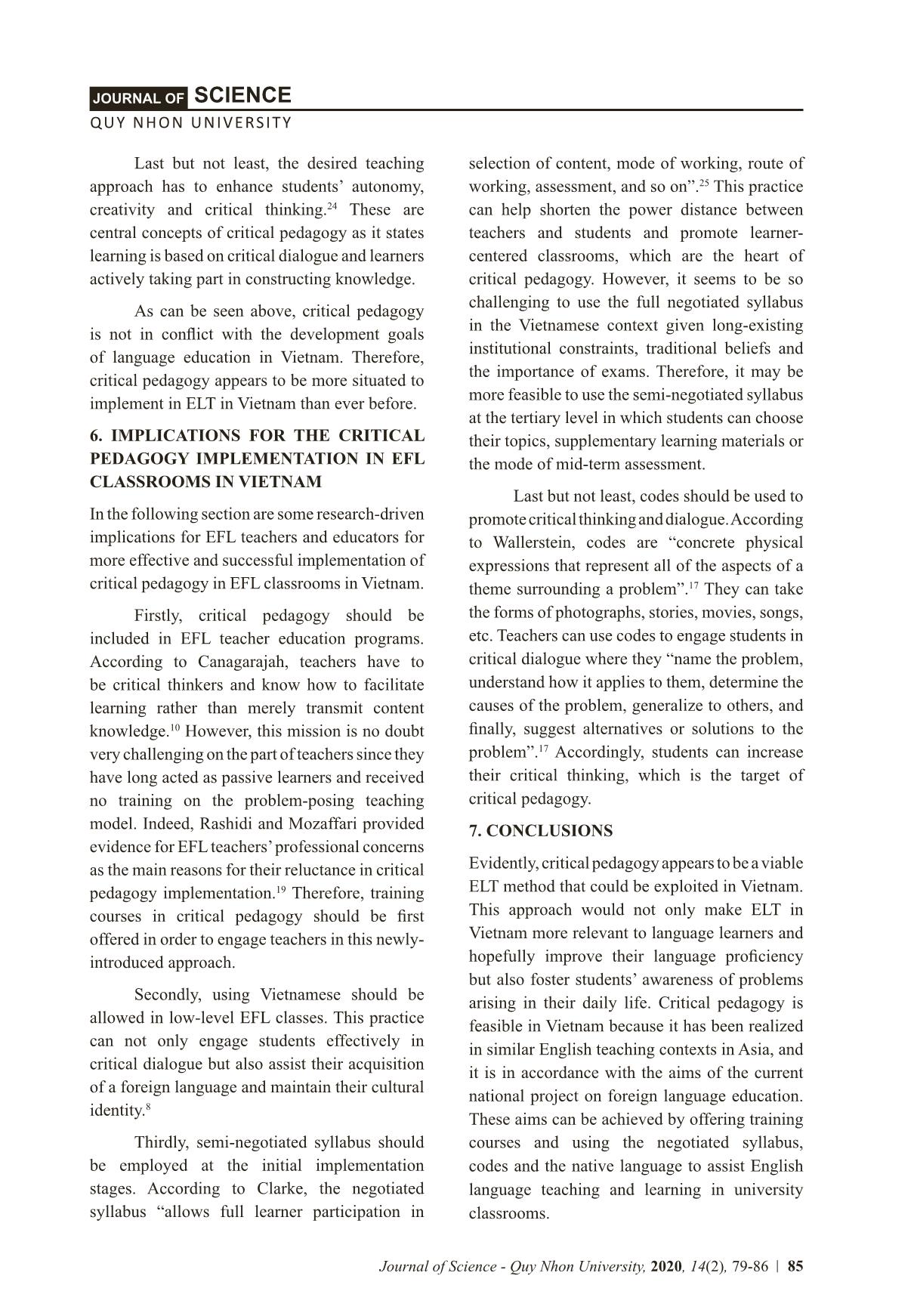
Trang 7
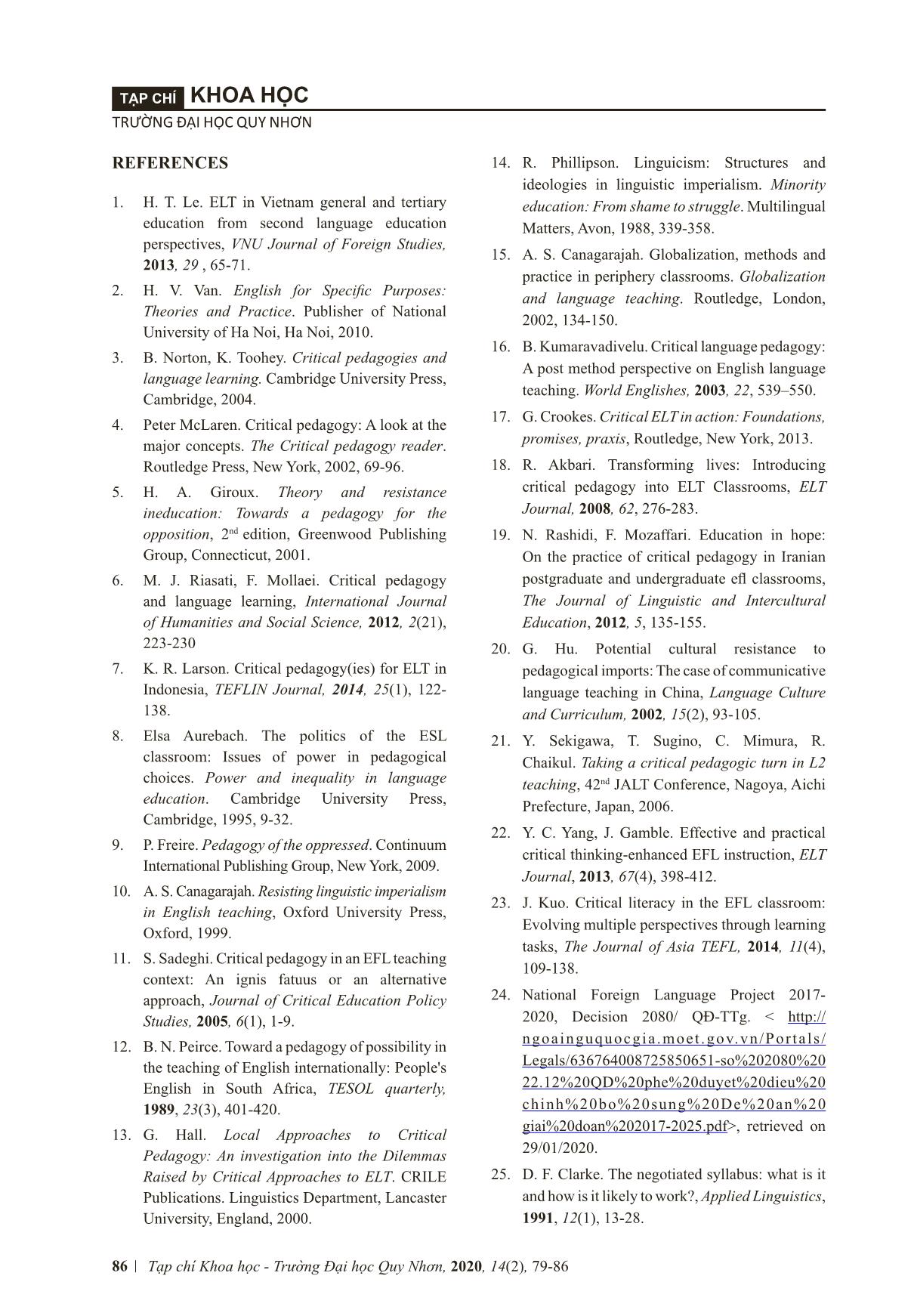
Trang 8
Bạn đang xem tài liệu "Phương pháp giáo dục phản biện cho lớp học tiếng Anh ở các trường đại học Việt Nam", để tải tài liệu gốc về máy hãy click vào nút Download ở trên
Tóm tắt nội dung tài liệu: Phương pháp giáo dục phản biện cho lớp học tiếng Anh ở các trường đại học Việt Nam
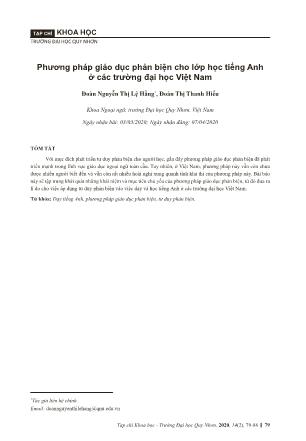
79Tạp chí Khoa học - Trường Đại học Quy Nhơn, 2020, 14(2), 79-86 Phương pháp giáo dục phản biện cho lớp học tiếng Anh ở các trường đại học Việt Nam Đoàn Nguyễn Thị Lệ Hằng*, Đoàn Thị Thanh Hiếu Khoa Ngoại ngữ, trường Đại học Quy Nhơn, Việt Nam Ngày nhận bài: 03/03/2020; Ngày nhận đăng: 07/04/2020 TÓM TẮT Với mục đích phát triển tư duy phản biện cho người học, gần đây phương pháp giáo dục phản biện đã phát triển mạnh trong lĩnh vực giáo dục ngoại ngữ toàn cầu. Tuy nhiên, ở Việt Nam, phương pháp này vẫn còn chưa được nhiều người biết đến và vẫn còn rất nhiều hoài nghi xung quanh tính khả thi của phương pháp này. Bài báo này sẽ tập trung khái quát những khái niệm và mục tiêu chủ yếu của phương pháp giáo dục phản biện, từ đó đưa ra lí do cho việc áp dụng tư duy phản biện vào việc dạy và học tiếng Anh ở các trường đại học Việt Nam. Từ khóa: Dạy tiếng Anh, phương pháp giáo dục phản biện, tư duy phản biện. *Tác giả liên hệ chính. Email: doannguyenthilehang@qnu.edu.vn TRƯỜNG ĐẠI HỌC QUY NHƠN KHOA HỌCTẠP CHÍ 80 Journal of Science - Quy Nhon University, 2020, 14(2), 79-86 Critical pedagogy for university English language classrooms in Vietnam Doan Nguyen Thi Le Hang*, Doan Thi Thanh Hieu Foreign Language Department, Quy Nhon University, Vietnam Received: 03/03/2020; Accepted: 07/04/2020 ABSTRACT Originally derived from critical thinking, critical pedagogy has rapidly emerged as a promising approach in language education worldwide. However, this method appears relatively novel and highly questionable in English language education in non-Western contexts like Vietnam. This paper, therefore, presents an overview of critical pedagogy as a language teaching approach and some arguments for the implementation of this approach to improve teaching and learning English as a foreign language in Vietnam, especially in tertiary classrooms. Keywords: critical thinking, critical pedagogy, English as a foreign language, English language education *Corresponding author. Email: doannguyenthilehang@qnu.edu.vn 1. INTRODUCTION English as a foreign language (EFL) has been significantly increasing in importance in Vietnam for the past few decades. Teaching English has come into the center focus in the national educational policy since this country sped up its integration into the world market in 2007. As an international language, English is considered as a bridge to the world outside. English is taught at all educational levels, and a certificate in English proficiency is required for all graduates. Nevertheless, English teaching and learning in Vietnam, especially at the tertiary level is not qualified as expected.1 After over ten years of learning English at school, the majority of graduates are still unable to communicate effectively in English.2 This failure can be attributed to different factors such as the serious shortage of learning facilities, teacher-dominated classrooms, grammar-based testing and assessment, and a limited relevant curriculum in working for students from diverse socio-economic backgrounds.1 Among these, the curriculum in use appears to exert a profound impact. As a result, there is a strong need for a change in EFL teaching in Vietnam. Meanwhile, researchers who are interested in meaningful and locally relevant curricula suggest critical pedagogy for an alternative approach in language teaching and learning.3 Taking learners’ voice as the center, critical pedagogy in EFL considers English language “as not simply a means of expression or communication but as a practice that constructs, and is constructed by, the ways language learners understand themselves, their social surroundings, their histories, and their possibilities for the future.”3 With this critical viewpoint in mind, this paper will argue that critical pedagogy could QUY NHON UNIVERSITY SCIENCEJOURNAL OF 81 QUY NHON UNIVERSITY SCIENCEJOURNAL OF Journal of Science - Quy Nhon University, 2020, 14(2), 79-86 serve as a solution for the current teaching situation in Vietnam. The paper will first present a brief description of critical pedagogy as a teaching approach in general and then in English language teaching in specific. The next two sections provide a review of research studies on the practicality and effectiveness of critical pedagogy in Asia and how this approach is compatible with a Vietnamese national project on EFL teaching. The paper will conclude with some implications to implement critical pedagogy for more improvements in English language education in Vietnam. 2. CRITICAL PEDAGOGY AS A TEACHING APPROACH First proposed by Brazilian educator Paulo Freirein, critical pedagogy is based on the premise that the world is always full of contradictions, inequality and unfairly distributed power and privilege.4 Even educational institutions, which are generally expected to work on neutral ground, indeed have been long serving as contributors to transmission and reproduction of dominant ideologies that are out of date and thus do not reflect learners’ need in real life.5 Consequently, critical pedagogy attempts to develop students’ ability to think critically about their own problems so that they can act on it and improve their life. Accordingly, a meaningful curriculum should include students’ life situations as primary contents and take dialogue as the center of learning process to avoid the one-way transmission of knowledge.6 Learners therefore can be empowered to act as agents for social changes.7 In other words, this approach to education aims to promote the learners’ life with a focus on action. Obviously, this approach is quite contradicted to the well-established teaching practices in many non - Western contexts, also called the banking model of education. This traditional model defines teaching merely as “transmission o ... pedagogy, the mismatch between this Western approach and the sociocultural context in Asia may cast serious doubts on its implementation in Vietnam. As widely acknowledged, ELT in Asian countries such as Japan, Vietnam, China or Taiwan, etc. has long considered learners as passive recipients of knowledge, teachers as the center of all activities and authority in classrooms, and the banking model as the most effective approach. These mismatching features that have been documented to lead to the failure in implementing the communicative language teaching, another well- known Western teaching approach.20 Despite these doubts, this approach, indeed, has been successfully put into practice in different Asian countries, especially at the tertiary level. Typically, in Iran the problem-posing approach of critical pedagogy was implemented in an EFL class by Sadeghi.11 His study aims to find out how this approach helps maintain discussions and develop students’ critical consciousness. Accordingly, his students were engaged in learning activities that could increase their awareness of social justice and their willingness to make more contribution to the society. After one semester, feedback from student participants show majority support for this approach and their strong preference for daily life topics raised by themselves and the teacher over decontextualized topics presented in the textbooks. Working towards the same goal, Sekigawa and his colleagues studied three different groups 84 TRƯỜNG ĐẠI HỌC QUY NHƠN KHOA HỌCTẠP CHÍ Tạp chí Khoa học - Trường Đại học Quy Nhơn, 2020, 14(2), 79-86 of EFL university students in Japan.21 They were nursing students, international students and those majoring in leadership. The main aims of the study are both to improve students’ speaking skill and to encourage them to express their own opinions for a higher critical consciousness. Findings reveal that at first the participant students felt anxious about this newly - introduced teaching method due to their low English proficiency, but later they could convey their ideas in English effectively on topics related to their own problems. Revealing the similar positive results, a study in Taiwan by Yang and Gamble used an experimental design with two freshman EFL classes to examine the practicality and effectiveness of activities enhancing critical thinking.22 While the experimental group took part in debates or peer critiques, the control group was involved in familiar activities such as group presentations and writing process. Data were collected from General English Proficiency Tests and content-based achievement tests for both groups as well as group projects and attitudinal questionnaires for the experimental group. Analyzing all the data shows that the experimental group outperformed the control group in both tests and demonstrated a higher critical-thinking skill. More recently, Kuo designed a critical thinking activity for non-English majors in Taiwan based on the theory of critical literacy.23 The activity engaged students in using a picture book in different learning tasks and then evaluating it from different perspectives. In order to clarify the effectiveness of this activity, the researcher analyzed data from classroom observation notes, participants’ reflection papers and assignments as well as follow-up interviews. Results indicate that learners acquired critical competence when investigating multiple perspectives and re-examining their real world. It can be seen from these studies that critical pedagogy has proved practicality and efficacy in various ELT contexts for higher education in Asia. Although similar research remains hard to locate in literature in Vietnam, these studies have provided support for critical pedagogy implementation there given its comparable learning culture. Another favorable condition can result from the correspondence between critical pedagogy and the goals of the National Foreign Language Education Project launched by the Vietnamese Ministry of Education and Training. 5. CRITICAL PEDAGOGY AND THE NATIONAL FOREIGN LANGUAGE PROJECT IN VIETNAM In an attempt to improve English language proficiency in Vietnam, a project called National Foreign Language Education Project was set up in 2008 in order to renovate the teaching and learning of foreign languages within the national educational system. The project mainly aims to enable Vietnamese university students to reach a globally recognized level of English language.24 Noticeably, this national project has some targets for the 2017 - 2025 period in accordance with critical pedagogy. Specifically, the ultimate goal of this project is to explore new approaches to make ELT more relevant, efficient and productive and to satisfy a variety of learners’ needs.24 As previously mentioned, critical pedagogy views learning as a contextualized and personalized process, so the teaching curriculum and materials in use have to be relevant to the target students to provide meaningful education.10 Another criterion of the target teaching approach in the Project is its capability to enable language learners to reflect students’ own values and prior learning experiences.24 Again, these aims are compatible with an important orientation of critical EFL pedagogy that considers learning as a means to tap on students’ previous knowledge and to maintain their identity as well as to respect their culture.10 85 QUY NHON UNIVERSITY SCIENCEJOURNAL OF Journal of Science - Quy Nhon University, 2020, 14(2), 79-86 Last but not least, the desired teaching approach has to enhance students’ autonomy, creativity and critical thinking.24 These are central concepts of critical pedagogy as it states learning is based on critical dialogue and learners actively taking part in constructing knowledge. As can be seen above, critical pedagogy is not in conflict with the development goals of language education in Vietnam. Therefore, critical pedagogy appears to be more situated to implement in ELT in Vietnam than ever before. 6. IMPLICATIONS FOR THE CRITICAL PEDAGOGY IMPLEMENTATION IN EFL CLASSROOMS IN VIETNAM In the following section are some research-driven implications for EFL teachers and educators for more effective and successful implementation of critical pedagogy in EFL classrooms in Vietnam. Firstly, critical pedagogy should be included in EFL teacher education programs. According to Canagarajah, teachers have to be critical thinkers and know how to facilitate learning rather than merely transmit content knowledge.10 However, this mission is no doubt very challenging on the part of teachers since they have long acted as passive learners and received no training on the problem-posing teaching model. Indeed, Rashidi and Mozaffari provided evidence for EFL teachers’ professional concerns as the main reasons for their reluctance in critical pedagogy implementation.19 Therefore, training courses in critical pedagogy should be first offered in order to engage teachers in this newly- introduced approach. Secondly, using Vietnamese should be allowed in low-level EFL classes. This practice can not only engage students effectively in critical dialogue but also assist their acquisition of a foreign language and maintain their cultural identity.8 Thirdly, semi-negotiated syllabus should be employed at the initial implementation stages. According to Clarke, the negotiated syllabus “allows full learner participation in selection of content, mode of working, route of working, assessment, and so on”.25 This practice can help shorten the power distance between teachers and students and promote learner- centered classrooms, which are the heart of critical pedagogy. However, it seems to be so challenging to use the full negotiated syllabus in the Vietnamese context given long-existing institutional constraints, traditional beliefs and the importance of exams. Therefore, it may be more feasible to use the semi-negotiated syllabus at the tertiary level in which students can choose their topics, supplementary learning materials or the mode of mid-term assessment. Last but not least, codes should be used to promote critical thinking and dialogue. According to Wallerstein, codes are “concrete physical expressions that represent all of the aspects of a theme surrounding a problem”.17 They can take the forms of photographs, stories, movies, songs, etc. Teachers can use codes to engage students in critical dialogue where they “name the problem, understand how it applies to them, determine the causes of the problem, generalize to others, and finally, suggest alternatives or solutions to the problem”.17 Accordingly, students can increase their critical thinking, which is the target of critical pedagogy. 7. CONCLUSIONS Evidently, critical pedagogy appears to be a viable ELT method that could be exploited in Vietnam. This approach would not only make ELT in Vietnam more relevant to language learners and hopefully improve their language proficiency but also foster students’ awareness of problems arising in their daily life. Critical pedagogy is feasible in Vietnam because it has been realized in similar English teaching contexts in Asia, and it is in accordance with the aims of the current national project on foreign language education. These aims can be achieved by offering training courses and using the negotiated syllabus, codes and the native language to assist English language teaching and learning in university classrooms. 86 TRƯỜNG ĐẠI HỌC QUY NHƠN KHOA HỌCTẠP CHÍ Tạp chí Khoa học - Trường Đại học Quy Nhơn, 2020, 14(2), 79-86 REFERENCES 1. H. T. Le. ELT in Vietnam general and tertiary education from second language education perspectives, VNU Journal of Foreign Studies, 2013, 29 , 65-71. 2. H. V. Van. English for Specific Purposes: Theories and Practice. Publisher of National University of Ha Noi, Ha Noi, 2010. 3. B. Norton, K. Toohey. Critical pedagogies and language learning. Cambridge University Press, Cambridge, 2004. 4. Peter McLaren. Critical pedagogy: A look at the major concepts. The Critical pedagogy reader. Routledge Press, New York, 2002, 69-96. 5. H. A. Giroux. Theory and resistance ineducation: Towards a pedagogy for the opposition, 2nd edition, Greenwood Publishing Group, Connecticut, 2001. 6. M. J. Riasati, F. Mollaei. Critical pedagogy and language learning, International Journal of Humanities and Social Science, 2012, 2(21), 223-230 7. K. R. Larson. Critical pedagogy(ies) for ELT in Indonesia, TEFLIN Journal, 2014, 25(1), 122- 138. 8. Elsa Aurebach. The politics of the ESL classroom: Issues of power in pedagogical choices. Power and inequality in language education. Cambridge University Press, Cambridge, 1995, 9-32. 9. P. Freire. Pedagogy of the oppressed. Continuum International Publishing Group, New York, 2009. 10. A. S. Canagarajah. Resisting linguistic imperialism in English teaching, Oxford University Press, Oxford, 1999. 11. S. Sadeghi. Critical pedagogy in an EFL teaching context: An ignis fatuus or an alternative approach, Journal of Critical Education Policy Studies, 2005, 6(1), 1-9. 12. B. N. Peirce. Toward a pedagogy of possibility in the teaching of English internationally: People's English in South Africa, TESOL quarterly, 1989, 23(3), 401-420. 13. G. Hall. Local Approaches to Critical Pedagogy: An investigation into the Dilemmas Raised by Critical Approaches to ELT. CRILE Publications. Linguistics Department, Lancaster University, England, 2000. 14. R. Phillipson. Linguicism: Structures and ideologies in linguistic imperialism. Minority education: From shame to struggle. Multilingual Matters, Avon, 1988, 339-358. 15. A. S. Canagarajah. Globalization, methods and practice in periphery classrooms. Globalization and language teaching. Routledge, London, 2002, 134-150. 16. B. Kumaravadivelu. Critical language pedagogy: A post method perspective on English language teaching. World Englishes, 2003, 22, 539–550. 17. G. Crookes. Critical ELT in action: Foundations, promises, praxis, Routledge, New York, 2013. 18. R. Akbari. Transforming lives: Introducing critical pedagogy into ELT Classrooms, ELT Journal, 2008, 62, 276-283. 19. N. Rashidi, F. Mozaffari. Education in hope: On the practice of critical pedagogy in Iranian postgraduate and undergraduate efl classrooms, The Journal of Linguistic and Intercultural Education, 2012, 5, 135-155. 20. G. Hu. Potential cultural resistance to pedagogical imports: The case of communicative language teaching in China, Language Culture and Curriculum, 2002, 15(2), 93-105. 21. Y. Sekigawa, T. Sugino, C. Mimura, R. Chaikul. Taking a critical pedagogic turn in L2 teaching, 42nd JALT Conference, Nagoya, Aichi Prefecture, Japan, 2006. 22. Y. C. Yang, J. Gamble. Effective and practical critical thinking-enhanced EFL instruction, ELT Journal, 2013, 67(4), 398-412. 23. J. Kuo. Critical literacy in the EFL classroom: Evolving multiple perspectives through learning tasks, The Journal of Asia TEFL, 2014, 11(4), 109-138. 24. National Foreign Language Project 2017- 2020, Decision 2080/ QĐ-TTg. < http:// ngoainguquocgia .moet .gov.vn/Por ta l s / Legals/636764008725850651-so%202080%20 22.12%20QD%20phe%20duyet%20dieu%20 chinh%20bo%20sung%20De%20an%20 giai%20doan%202017-2025.pdf>, retrieved on 29/01/2020. 25. D. F. Clarke. The negotiated syllabus: what is it and how is it likely to work?, Applied Linguistics, 1991, 12(1), 13-28.
File đính kèm:
 phuong_phap_giao_duc_phan_bien_cho_lop_hoc_tieng_anh_o_cac_t.pdf
phuong_phap_giao_duc_phan_bien_cho_lop_hoc_tieng_anh_o_cac_t.pdf

